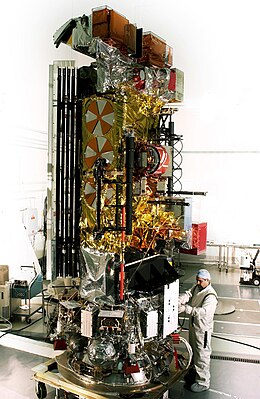NOAA-17
Appearance
This article needs additional citations for verification. (December 2013) |
 NOAA-M before launch | |
| Mission type | Weather satellite |
|---|---|
| Operator | NOAA |
| COSPAR ID | 2002-032A |
| SATCAT no. | 27453 |
| Mission duration | 2 years[1] |
| Spacecraft properties | |
| Spacecraft type | TIROS-N |
| Manufacturer | Lockheed Martin |
| Launch mass | 1,457 kilograms (3,212 lb)[2] |
| Power | 830 watts[3] |
| Start of mission | |
| Launch date | June 24, 2002, 18:23:04 UTC[4] |
| Rocket | Titan II(23)G Star-37XFP-ISS |
| Launch site | Vandenberg SLC-4W |
| End of mission | |
| Disposal | Decommissioned |
| Deactivated | April 10, 2013[5] |
| Orbital parameters | |
| Reference system | Geocentric |
| Regime | Sun-synchronous |
| Semi-major axis | 7,187.63 kilometers (4,466.19 mi) |
| Eccentricity | 0.0011757 |
| Perigee altitude | 808 kilometers (502 mi) |
| Apogee altitude | 825 kilometers (513 mi) |
| Inclination | 98.31 degrees |
| Period | 101.07 minutes |
| Epoch | December 8, 2013, 12:57:13 UTC[6] |
NOAA-17 was a weather forecasting satellite operated by NOAA. It was launched on June 24, 2002, in a sun-synchronous orbit, 824 km above the Earth, orbiting every 101 minutes. It hosted the AMSU, AVHRR and High Resolution Infrared Radiation Sounder (HRIS) instruments. The satellite was retired in 2013.
Automatic Picture Transmission frequency was 137.5 MHz.
NOAA-17 was decommissioned on April 10, 2013.[5]
External Links
References
- ^ Krebs, Gunter. "NOAA 15, 16, 17 (NOAA K, L, M)". Gunther's Space Page. Retrieved December 8, 2013.
- ^ "NOAA 17". National Space Science Data Center. Retrieved December 9, 2013.
- ^ "UCS Satellite Database". Union of Concerned Scientists. Archived from the original on January 3, 2013. Retrieved December 9, 2013.
- ^ McDowell, Jonathan. "Launch Log". Jonathan's Space Page. Retrieved December 9, 2013.
- ^ a b "NASA Office of Spacecraft Operations, NOAA 17 Spacecraft Status Summary". Archived from the original on July 17, 2012.
- ^ "NOAA 17 Satellite details 2002-032A NORAD 27453". N2YO. December 8, 2013. Retrieved December 9, 2013.

